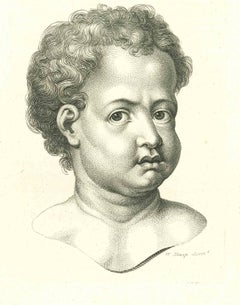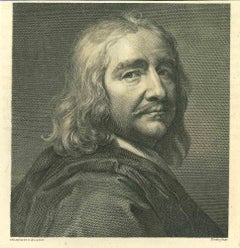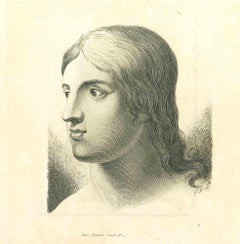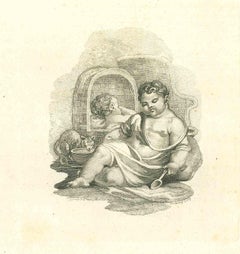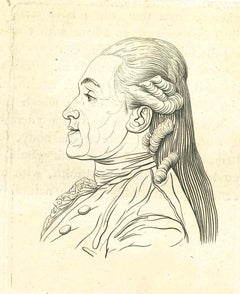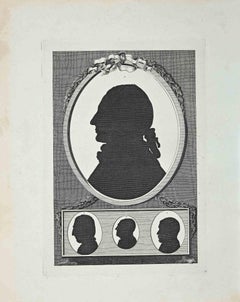1810s Art
to
70
512
29
26
6
4
Overall Width
to
Overall Height
to
7,511
21,290
158,175
232,640
1,959
2,229
4,876
6,389
5,802
13,214
19,530
25,571
18,140
13,470
5,368
269
153
1
1
320
243
11
481
216
215
207
187
125
101
96
71
55
50
32
20
13
12
11
11
10
10
10
496
90
47
32
22
309
15
15
3
3
41
478
165
37
Period: 1810s
Portrait - Etching by William Sharp - 1810
Located in Roma, IT
Portrait is an original artwork realized by William Sharp (1749 - 1824).
Original Etching from J.C. Lavater's "Essays on Physiognomy, Designed to promot...
Category
Modern 1810s Art
Materials
Etching
Portrait - Original Etching by Thomas Trotter - 1810
Located in Roma, IT
Portrait is an original artwork realized after Thomas Trotter (1756 - 1803).
Original Etching from J.C. Lavater's "Essays on Physiognomy, Designed to promote the Knowledge and the L...
Category
Old Masters 1810s Art
Materials
Etching
$249 Sale Price
30% Off
Portrait - Original Etching by Johann Caspar Lavater - 1810
Located in Roma, IT
Portrait is an original artwork realized by Johann Caspar Lavater (1741 - 1801).
Original Etching from "Essays on Physiognomy, Designed to promote the Knowledge and the Love of Mank...
Category
Old Masters 1810s Art
Materials
Etching
$249 Sale Price
30% Off
Portrait - Original Etching by Thomas Holloway - 1810
Located in Roma, IT
Portrait is an original artwork realized by Thomas Holloway (1748 - 1827).
Original Etching from J.C. Lavater's "Essays on Physiognomy, Designed to promote the Knowledge and the Lov...
Category
Old Masters 1810s Art
Materials
Etching
Portrait - Original Etching by Thomas Holloway - 1810
Located in Roma, IT
Portrait is an original artwork realized by Thomas Holloway (1748 - 1827).
Original Etching from J.C. Lavater's "Essays on Physiognomy, Designed to promote the Knowledge and the Lov...
Category
Old Masters 1810s Art
Materials
Etching
Silhouettes - Original Etching by Thomas Holloway - 1810
Located in Roma, IT
Silhouettes is an original artwork realized by Thomas Holloway (1748 - 1827).
Original Etching from J.C. Lavater's "Essays on Physiognomy, Designed to promote the Knowledge and the ...
Category
Old Masters 1810s Art
Materials
Etching
$291 Sale Price
30% Off
Silhouettes - Original Etching by Thomas Holloway - 1810
Located in Roma, IT
Silhouette is an original artwork realized by Thomas Holloway (1748 - 1827).
Original Etching from J.C. Lavater's "Essays on Physiognomy, Designed to promote the Knowledge and the L...
Category
Old Masters 1810s Art
Materials
Etching
$291 Sale Price
30% Off
Portrait - Original Etching by Thomas Holloway - 1810
Located in Roma, IT
Portrait is an original artwork realized by Thomas Holloway (1748 - 1827).
Original Etching from J.C. Lavater's "Essays on Physiognomy, Designed to promote the Knowledge and the Lov...
Category
Old Masters 1810s Art
Materials
Etching
Portrait - Original Etching by Thomas Holloway - 1810
Located in Roma, IT
Portrait is an original artwork realized by Thomas Holloway (1748 - 1827).
Original Etching from J.C. Lavater's "Essays on Physiognomy, Designed to promote the Knowledge and the Lov...
Category
Old Masters 1810s Art
Materials
Etching
Portrait - Original Etching by Thomas Holloway - 1810
Located in Roma, IT
Portrait is an original artwork realized by Thomas Holloway (1748 - 1827).
Original Etching from J.C. Lavater's "Essays on Physiognomy, Designed to promote the Knowledge and the Lov...
Category
Old Masters 1810s Art
Materials
Etching
Portrait - Original Etching by Johann Caspar Lavater - 1810
Located in Roma, IT
Portrait is an original artwork realized by Thomas Trotter (1748 - 1827).
Original Etching from "Essays on Physiognomy, Designed to promote the Knowledge and the Love of Mankind", ...
Category
Old Masters 1810s Art
Materials
Etching
Roman Girls Return from the Harvest - Etching by Bartolomeo Pinelli - 1819
Located in Roma, IT
Romane ritornando dalla vendemmia is a precious hand-colored etching by Bartolomeo Pinelli. The inscriptions are at the bottom, inside the matrix, and just below the image. On the le...
Category
Realist 1810s Art
Materials
Etching
Liber Veritatis - Original B/W Etching after Claude Lorrain - 1815
Located in Roma, IT
Image dimensions: 21 x 27 cm.
Liber Veritatis - Plate 95 is a beautiful black and white etching and aquatint on paper realized by the Italian artist Ludovico Caracciolo, after Claud...
Category
Old Masters 1810s Art
Materials
Etching, Aquatint
Roma Costumi Trasteverini - Etching by Bartolomeo Pinelli - 1819
Located in Roma, IT
Roma Costumi trasteverini is a beautiful artwork realized by Bartolomeo Pinelli in 1819.
Etching and Watercolor technique. In Good condition, worn paper on the marginal line and som...
Category
Realist 1810s Art
Materials
Etching
Chinese Butterflies and Silk Worms with Lychee Nuts
Located in New York, NY
Original Chinese Export School gouache.
Category
1810s Art
Materials
Gouache, Handmade Paper
Architectural Details of St Albans Cathedral (1810), engraving by James Basire
Located in London, GB
James Basire & John Carter
Architectural details of St Albans Cathedral
Engraving
62 x 46 cm
This engraving was originally published by the Society of Antiquaries of London, an o...
Category
Realist 1810s Art
Materials
Engraving
GALLESIO. A Group of Six Grapes.
Located in London, GB
Six hand-coloured plates of Grapes, printed in colour and finished by hand. Framed and glazed, overall size: 42.5 by 57.5cm. Pomona Italiana Ossia Trattato Degli Alberi Fruttiferi...
Category
Naturalistic 1810s Art
Materials
Handmade Paper, Engraving
Design fragments of St Albans Cathedral (1810), engraving by James Basire
Located in London, GB
James Basire & John Carter
Architectural Fragments of St Albans Cathedral
Engraving
62 x 46 cm
This engraving was originally published by the Society of Antiquaries of London, an...
Category
Realist 1810s Art
Materials
Engraving
King's College, Cambridge engraving by Havell for Ackermann
Located in London, GB
To see our other Oxford and Cambridge pictures, including an extensive collection of works by Ackermann, scroll down to "More from this Seller" and below it click on "See all from th...
Category
Realist 1810s Art
Materials
Aquatint, Engraving
Design Fragments of St Albans Cathedral (1810), engraving by James Basire
Located in London, GB
James Basire & John Carter
Architectural Fragments of St Albans Cathedral
Engraving
60 x 44 cm
This engraving was originally published by the Society of Antiquaries of London, an...
Category
Realist 1810s Art
Materials
Engraving
Architectural Details of St Albans Cathedral (1810), engraving by James Basire
Located in London, GB
James Basire & John Carter
Architectural details of St Albans Cathedral
Engraving
62 x 46 cm
This engraving was originally published by the Society of Antiquaries of London, an ...
Category
Realist 1810s Art
Materials
Engraving
Architecture Fragments of St Albans Cathedral (1810), engraving by James Basire
Located in London, GB
James Basire & John Carter
Architectural Fragments of St Albans Cathedral
Engraving
44 x 62 cm
This engraving was originally published by the Society of Antiquaries of London, an...
Category
Realist 1810s Art
Materials
Engraving
Students of Emmanuel and Trinity Colleges, Cambridge 1815 engraving by John Agar
Located in London, GB
To see our other Oxford and Cambridge pictures, including an extensive collection of works by Ackermann, scroll down to "More from this Seller" and below it click on "See all from th...
Category
Realist 1810s Art
Materials
Aquatint
A Youth at His Devotions /// after Raphael Raffaello Sanzio Renaissance Italian
Located in Saint Augustine, FL
Artist: William Young Ottley (English, 1771-1836)
Title: "A Youth at His Devotions"
Portfolio: The Italian School of Design: Being a Series of Fac-Similes of Original Drawings, By th...
Category
Victorian 1810s Art
Materials
Etching, Intaglio
Gate of Christ Church, Oxford engraving by Reeves after Mackenzie for Ackermann
Located in London, GB
To see our other Oxford and Cambridge pictures, including an extensive collection of works by Ackermann, scroll down to "More from this Seller" and below it click on "See all from th...
Category
Realist 1810s Art
Materials
Aquatint
Architectural view of Exeter Cathedral (1797), engraving by James Basire
Located in London, GB
James Basire & John Carter
Architectural view of Exeter Cathedral
Engraving
61 x 95 cm
This engraving was originally published by the Society of Antiquaries of London, an organisa...
Category
Realist 1810s Art
Materials
Engraving
The Abbey Church of St Albans (1810), engraving by James Basire
Located in London, GB
James Basire & John Carter
The Abbey Church of St Albans
Engraving
62 x 46 cm
This engraving was originally published by the Society of Antiquaries of London, an organisation dedi...
Category
Realist 1810s Art
Materials
Engraving
Architectural Segments of St Albans Cathedral (1810), engraving by James Basire
Located in London, GB
James Basire & John Carter
Specimens of the Architecture and Ornaments of the Abbey Church at St Albans
Engraving
62 x 46 cm
This engraving was originally published by the Societ...
Category
Realist 1810s Art
Materials
Engraving
Architectural Fragment of St Albans Cathedral (1810), engraving by James Basire
Located in London, GB
James Basire & John Carter
Architectural fragments of St Albans Cathedral
Engraving
62 x 46 cm
This engraving was originally published by the Society of Antiquaries of London, an...
Category
Realist 1810s Art
Materials
Engraving
Queens' College, Cambridge hall engraving by Bluck after Pugin for Ackermann
Located in London, GB
To see our other Oxford and Cambridge pictures, including an extensive collection of works by Ackermann, scroll down to "More from this Seller" and below it click on "See all from th...
Category
1810s Art
Materials
Aquatint
Tom Tower, Christ Church, St Aldate's, Oxford by Hill after Pugin for Ackermann
Located in London, GB
To see our other Oxford and Cambridge pictures, including an extensive collection of works by Ackermann, scroll down to "More from this Seller" and below it click on "See all from this Seller" - or send us a message if you cannot find the view you want.
John Hill (1770 - 1850) after Augustus Charles Pugin (1762 - 1832)
St Aldate's From Carfax (1813)
Aquatint with original hand colouring
27 x 21 cm
Published by Rudolph Ackermann (1764 - 1834).
An engraving of St Aldate's, overlooked by Christ Church's pale and magnificent Tom Tower.
John Hill was born in London in 1770, and was an engraver's apprentice. He worked in aquatint and largely produced book illustration aquatints. He went to America in 1816 and produced the notable Picturesque Views of American Scenery amongst other books of prints.
Augustus Charles Pugin was an Anglo-French artist and architectural draughtsman. Pugin produced views of London, jointly creating the illustrations for the 'Microcosm of London' published by Rudolph Ackermann in 1811, followed by plates for Ackermann's books about Westminster Abbey, Oxford and Cambridge universities, and Winchester College. His later works included illustrations for Specimens of Gothic Architecture (1821–1823), The Royal Pavilion at Brighton (1826), Architectural Antiquities of Great Britain (1826), Specimens of the Architectural Antiquities of Normandy (1827), Illustrations of the Public Buildings of London (1825 to 1828), Paris and its Environs (1829 to 1831), and Examples of Gothic Architecture (1831). He also produced a book of furniture designs called Gothic Furniture, and assisted architects with detailing for their gothic designs. He ran a drawing school at his house in Bloomsbury.
Ackermann was an Anglo-German bookseller, inventor, lithographer, publisher and businessman. He attended the Latin school in Stollberg, but his wish to study at the university was made impossible by lack of financial means, and he therefore became a saddler like his father.
He worked as a saddler and coach-builder in different German cities, moved from Dresden to Basel and Paris, and then, 23 years old, settled in London. He established himself in Long Acre, the centre of coach-making in London and close to the market at Covent Garden.
Ackermann then moved to Little Russell Street where he published Imitations of Drawings of Fashionable Carriages (1791) to promote his coach-making. Other publications followed. In 1795 he established a print-shop and drawing-school at 96 Strand. Here Ackermann set up a lithographic press and began a trade in prints. He later began to manufacture colours and thick carton paper for landscape and miniature painters. Within three years the premises had become too small and he moved to 101 Strand, in his own words "four doors nearer to Somerset House", the seat of the Royal Academy of Arts.
Between 1797 and 1800 Ackermann rapidly developed his print and book publishing business, encompassing many different genres including topography, caricature, portraits, transparencies and decorative prints.
During the Napoleonic wars, Ackermann was an energetic supporter of the Allied cause and made significant contributions to British propaganda through his publication of anti-Napoleonic prints...
Category
1810s Art
Materials
Aquatint
Queens' College, Cambridge engraving by Bluck for Ackermann
Located in London, GB
To see our other Oxford and Cambridge pictures, including an extensive collection of works by Ackermann, scroll down to "More from this Seller" and below it click on "See all from th...
Category
Realist 1810s Art
Materials
Aquatint
Trinity College, Cambridge Great Court engraving by Bluck for Ackermann
Located in London, GB
To see our other Oxford and Cambridge pictures, including an extensive collection of works by Ackermann, scroll down to "More from this Seller" and below it click on "See all from th...
Category
Realist 1810s Art
Materials
Aquatint
Chinese Craft on the Pearl River.
Located in London, GB
[CHINESE SCHOOL].
Chinese Craft on the Pearl River.
Canton, circa 1810.
A pencil, water colour and body colour drawing of craft, heightened with white on paper watermarked ‘J Whatm...
Category
Naturalistic 1810s Art
Materials
Watercolor
St. Alban's Abbey Church, High Altar screen /// Robert Clutterbuck Hertford Art
Located in Saint Augustine, FL
Artist: Robert Clutterbuck (English, 1772-1831)
Title: "St. Alban's Abbey Church, High Altar screen"
Portfolio: The History and Antiquities of the County of Hertford
Year: 1815-1827 (First edition)
Medium: Original Engraving on wove paper
Limited edition: Unknown
Printer: Nichols, Son, and Bentley, London, UK
Publisher: Nichols, Son, and Bentley, London, UK
Reference: Brunet II, No. 112; Lowndes No. 483; BAL RIBA No. 666; Upcott I, page 623
Sheet size: 17.63" x 11.38"
Image size: 11.57" x 8.57"
Condition: Scattered foxing throughout sheet; it doesn't show much within the image. Creasing to upper left and right corners. Has been professionally stored away for decades. It is otherwise a strong impression in good condition
Notes:
Provenance: private collection - Aspen, CO. Engraved by English artist John Henry Le Keux (1812-1896) after a drawing by English artist Frederick Nash (1782-1856). Comes from Clutterbuck's three volume "The History and Antiquities of the County of Hertford", (1815-1827) (First edition), which consists of 54 engravings. Printed from one copper plate on one color: black. "Vol. I. p. 65" printed upper right in margin. "Proof" printed lower right in margin.
St Albans Cathedral, officially the Cathedral and Abbey Church of St Alban, also known as "the Abbey", is a Church of England cathedral...
Category
Old Masters 1810s Art
Materials
Engraving, Intaglio
Sidney Sussex College, Cambridge engraving by Havell after Pugin for Ackermann
Located in London, GB
To see our other Oxford and Cambridge pictures, including an extensive collection of works by Ackermann, scroll down to "More from this Seller" and below it click on "See all from th...
Category
1810s Art
Materials
Aquatint
Trinity College, Cambridge Hall engraving by Bluck after Pugin for Ackermann
Located in London, GB
To see our other Oxford and Cambridge pictures, including an extensive collection of works by Ackermann, scroll down to "More from this Seller" and below it click on "See all from th...
Category
1810s Art
Materials
Aquatint, Engraving
Queens' College, Cambridge bridge engraving by Stadler after Westall
Located in London, GB
To see our other Oxford and Cambridge pictures, including an extensive collection of works by Ackermann, scroll down to "More from this Seller" and below it click on "See all from th...
Category
Realist 1810s Art
Materials
Engraving, Aquatint
Chinese Craft on the Pearl River.
Located in London, GB
[CHINESE SCHOOL].
Chinese Craft on the Pearl River.
Canton, circa 1810.
Pencil, water colour and body colour drawings of craft, heightened with white on paper watermarked ‘J Whatm...
Category
Naturalistic 1810s Art
Materials
Watercolor
New College, Oxford chapel window engraving after Joshua Reynolds' design
Located in London, GB
To see our other views of Oxford and Cambridge, scroll down to "More from this Seller" and below it click on "See all from this Seller" - or send us a message if you cannot find the ...
Category
1810s Art
Materials
Engraving, Aquatint
Peterhouse, Cambridge 'Chapel of St Peter's College' engraving by Havell
Located in London, GB
To see our other Oxford and Cambridge pictures, including an extensive collection of works by Ackermann, scroll down to "More from this Seller" and below it click on "See all from th...
Category
1810s Art
Materials
Engraving, Aquatint
Jesus College, Cambridge 1815 engraving by Joseph Stadler for Ackermann
Located in London, GB
To see our other Oxford and Cambridge pictures, including an extensive collection of works by Ackermann, scroll down to "More from this Seller" and below it click on "See all from this Seller" - or send us a message if you cannot find the view you want.
Joseph Constantine Stadler (1755 - 1828) after William Westall (1781 - 1850)
Jesus College...
Category
Realist 1810s Art
Materials
Aquatint
Margaret Countess of Richmond, Christ's College, Cambridge engraving
Located in London, GB
To see our other Oxford and Cambridge pictures, including an extensive collection of works by Ackermann, scroll down to "More from this Seller" and below it click on "See all from th...
Category
Realist 1810s Art
Materials
Aquatint
Mary, Countess of Pembroke, Pembroke College, Cambridge engraving for Ackermann
Located in London, GB
To see our other Oxford and Cambridge pictures, including an extensive collection of works by Ackermann, scroll down to "More from this Seller" and below it click on "See all from th...
Category
Realist 1810s Art
Materials
Aquatint
Chapel of All Souls College, Oxford engraving by Joseph Stadler for Ackermann
Located in London, GB
To see our other Oxford and Cambridge pictures, including an extensive collection of works by Ackermann, scroll down to "More from this Seller" and below it click on "See all from th...
Category
Realist 1810s Art
Materials
Aquatint
Chapel of Lincoln College, Oxford by Lewis after Mackenzie for Ackermann
Located in London, GB
To see our other Oxford and Cambridge pictures, including an extensive collection of works by Ackermann, scroll down to "More from this Seller" and below it click on "See all from th...
Category
Realist 1810s Art
Materials
Aquatint
Chapel of Magdalen College, Oxford engraving by Havell for Ackermann
Located in London, GB
To see our other Oxford and Cambridge pictures, including an extensive collection of works by Ackermann, scroll down to "More from this Seller" and below it click on "See all from th...
Category
Realist 1810s Art
Materials
Aquatint
Doctor in Divinity, Oxford engraving by Agar after Uwins for Ackermann
Located in London, GB
To see our other Oxford and Cambridge pictures, including an extensive collection of works by Ackermann, scroll down to "More from this Seller" and below it click on "See all from this Seller" - or send us a message if you cannot find the view you want.
John Samuel Agar (1773 - 1858) after John Uwins (1782 - 1857)
Doctor in Divinity (1814)
Aquatint with original hand colouring
29 x 24 cm
Published by Rudolph Ackermann (1764 - 1834).
A Doctor in Divinity of the University of Oxford, resplendent in academic dress.
Thomas Uwins RA RWS was a British painter in watercolour and oil, and a book illustrator. He became a full member of the Old Watercolour Society and a Royal Academician, and held a number of high-profile art appointments including the librarian of the Royal Academy, Surveyor of Pictures to Queen Victoria and the Keeper of the National Gallery. In the late 1790s he began producing work for Ackermann's collections.
John Samuel Agar was an English portrait painter and engraver, who exhibited his works at the Royal Academy from 1796 to 1806 and at the British Institution until 1811. He was at one time president of the Society of Engravers. Rudolph Ackermann published many of his engravings.
Ackermann was an Anglo-German bookseller, inventor, lithographer, publisher and businessman. He attended the Latin school in Stollberg, but his wish to study at the university was made impossible by lack of financial means, and he therefore became a saddler like his father.
He worked as a saddler and coach-builder in different German cities, moved from Dresden to Basel and Paris, and then, 23 years old, settled in London. He established himself in Long Acre, the centre of coach-making in London and close to the market at Covent Garden.
Ackermann then moved to Little Russell Street where he published Imitations of Drawings of Fashionable Carriages (1791) to promote his coach-making. Other publications followed. In 1795 he established a print-shop and drawing-school at 96 Strand. Here Ackermann set up a lithographic press and began a trade in prints. He later began to manufacture colours and thick carton paper for landscape and miniature painters. Within three years the premises had become too small and he moved to 101 Strand, in his own words "four doors nearer to Somerset House", the seat of the Royal Academy of Arts.
Between 1797 and 1800 Ackermann rapidly developed his print and book publishing business, encompassing many different genres including topography, caricature, portraits, transparencies and decorative prints.
During the Napoleonic wars, Ackermann was an energetic supporter of the Allied cause and made significant contributions to British propaganda through his publication of anti-Napoleonic prints...
Category
1810s Art
Materials
Aquatint
Chinese Craft on the Pearl River.
Located in London, GB
[CHINESE SCHOOL].
Chinese Craft on the Pearl River.
Canton, circa 1810.
A pencil, water colour and body colour drawing of craft, heightened with white on paper watermarked ‘J Whatm...
Category
Other Art Style 1810s Art
Materials
Watercolor
University of Oxford Bachelor engraving by Agar after Uwins for Ackermann
Located in London, GB
To see our other Oxford and Cambridge pictures, including an extensive collection of works by Ackermann, scroll down to "More from this Seller" and below it click on "See all from this Seller" - or send us a message if you cannot find the view you want.
John Samuel Agar (1773 - 1858) after John Uwins (1782 - 1857)
Servitor, Bachelor of Divinity, Collector (1814)
Aquatint with original hand colouring
24 x 29 cm
Published by Rudolph Ackermann (1764 - 1834).
A Servitor; Bachelor of Divinity; and Collector of the University of Oxford.
Thomas Uwins RA RWS was a British painter in watercolour and oil, and a book illustrator. He became a full member of the Old Watercolour Society and a Royal Academician, and held a number of high-profile art appointments including the librarian of the Royal Academy, Surveyor of Pictures to Queen Victoria and the Keeper of the National Gallery. In the late 1790s he began producing work for Ackermann's collections.
John Samuel Agar was an English portrait painter and engraver, who exhibited his works at the Royal Academy from 1796 to 1806 and at the British Institution until 1811. He was at one time president of the Society of Engravers. Rudolph Ackermann published many of his engravings.
Ackermann was an Anglo-German bookseller, inventor, lithographer, publisher and businessman. He attended the Latin school in Stollberg, but his wish to study at the university was made impossible by lack of financial means, and he therefore became a saddler like his father.
He worked as a saddler and coach-builder in different German cities, moved from Dresden to Basel and Paris, and then, 23 years old, settled in London. He established himself in Long Acre, the centre of coach-making in London and close to the market at Covent Garden.
Ackermann then moved to Little Russell Street where he published Imitations of Drawings of Fashionable Carriages (1791) to promote his coach-making. Other publications followed. In 1795 he established a print-shop and drawing-school at 96 Strand. Here Ackermann set up a lithographic press and began a trade in prints. He later began to manufacture colours and thick carton paper for landscape and miniature painters. Within three years the premises had become too small and he moved to 101 Strand, in his own words "four doors nearer to Somerset House", the seat of the Royal Academy of Arts.
Between 1797 and 1800 Ackermann rapidly developed his print and book publishing business, encompassing many different genres including topography, caricature, portraits, transparencies and decorative prints.
During the Napoleonic wars, Ackermann was an energetic supporter of the Allied cause and made significant contributions to British propaganda through his publication of anti-Napoleonic prints...
Category
1810s Art
Materials
Aquatint
St Sepulchre, The Round Church, Cambridge interior after Pugin for Ackermann
Located in London, GB
To see our other Oxford and Cambridge pictures, including an extensive collection of works by Ackermann, scroll down to "More from this Seller" and below it click on "See all from this Seller" - or send us a message if you cannot find the view you want.
John Hill (1770 - 1850) after Augustus Charles Pugin (1762 - 1832)
St Sepulchre's - The Round Church (1814)
Aquatint with original hand colouring
24 x 29 cm
Published by Rudolph Ackermann (1764 - 1834).
An interior engraving of the Church of the Holy Sepulchre, Cambridge, the round shape of which is inspired by the rotunda in the church of the Holy Sepulchre, Jerusalem.
John Hill was born in London in 1770, and was an engraver's apprentice. He worked in aquatint and largely produced book illustration aquatints. He went to America in 1816 and produced the notable Picturesque Views of American Scenery amongst other books of prints.
Augustus Charles Pugin was an Anglo-French artist and architectural draughtsman. Pugin produced views of London, jointly creating the illustrations for the 'Microcosm of London' published by Rudolph Ackermann in 1811, followed by plates for Ackermann's books about Westminster Abbey, Oxford and Cambridge universities, and Winchester College. His later works included illustrations for Specimens of Gothic Architecture (1821–1823), The Royal Pavilion at Brighton (1826), Architectural Antiquities of Great Britain (1826), Specimens of the Architectural Antiquities of Normandy (1827), Illustrations of the Public Buildings of London (1825 to 1828), Paris and its Environs (1829 to 1831), and Examples of Gothic Architecture (1831). He also produced a book of furniture designs called Gothic Furniture, and assisted architects with detailing for their gothic designs. He ran a drawing school at his house in Bloomsbury.
Ackermann was an Anglo-German bookseller, inventor, lithographer, publisher and businessman. He attended the Latin school in Stollberg, but his wish to study at the university was made impossible by lack of financial means, and he therefore became a saddler like his father.
He worked as a saddler and coach-builder in different German cities, moved from Dresden to Basel and Paris, and then, 23 years old, settled in London. He established himself in Long Acre, the centre of coach-making in London and close to the market at Covent Garden.
Ackermann then moved to Little Russell Street where he published Imitations of Drawings of Fashionable Carriages (1791) to promote his coach-making. Other publications followed. In 1795 he established a print-shop and drawing-school at 96 Strand. Here Ackermann set up a lithographic press and began a trade in prints. He later began to manufacture colours and thick carton paper for landscape and miniature painters. Within three years the premises had become too small and he moved to 101 Strand, in his own words "four doors nearer to Somerset House", the seat of the Royal Academy of Arts.
Between 1797 and 1800 Ackermann rapidly developed his print and book publishing business, encompassing many different genres including topography, caricature, portraits, transparencies and decorative prints.
During the Napoleonic wars, Ackermann was an energetic supporter of the Allied cause and made significant contributions to British propaganda through his publication of anti-Napoleonic prints...
Category
1810s Art
Materials
Aquatint
Fellow Commoner, University of Oxford 1814 engraving by John Agar
Located in London, GB
To see our other Oxford and Cambridge pictures, including an extensive collection of works by Ackermann, scroll down to "More from this Seller" and below it click on "See all from th...
Category
Realist 1810s Art
Materials
Aquatint
Trinity College, Cambridge library colonnade engraving by Stadler after Westall
Located in London, GB
To see our other Oxford and Cambridge pictures, including an extensive collection of works by Ackermann, scroll down to "More from this Seller" and below it click on "See all from this Seller" - or send us a message if you cannot find the view you want.
Joseph Constantine Stadler (1755 - 1828) after William Westall (1781 - 1850)
Colonnade under Trinity Library...
Category
Realist 1810s Art
Materials
Engraving, Aquatint
Frances Sidney, Sidney Sussex College, Cambridge engraving for Ackermann
Located in London, GB
To see our other Oxford and Cambridge pictures, including an extensive collection of works by Ackermann, scroll down to "More from this Seller" and below it click on "See all from th...
Category
Realist 1810s Art
Materials
Aquatint
Henry VIII Founder of Trinity College, Cambridge engraving for Ackermann
Located in London, GB
To see our other Oxford and Cambridge pictures, including an extensive collection of works by Ackermann, scroll down to "More from this Seller" and below it click on "See all from th...
Category
Realist 1810s Art
Materials
Engraving, Aquatint
Trinity Gate, Trinity College, Cambridge engraving by Stadler after Westall
Located in London, GB
To see our other Oxford and Cambridge pictures, including an extensive collection of works by Ackermann, scroll down to "More from this Seller" and below it click on "See all from th...
Category
Realist 1810s Art
Materials
Engraving, Aquatint
Gentleman Commoner, University of Oxford 1814 engraving by John Agar
Located in London, GB
To see our other Oxford and Cambridge pictures, including an extensive collection of works by Ackermann, scroll down to "More from this Seller" and below it click on "See all from th...
Category
Realist 1810s Art
Materials
Aquatint
Library of Trinity College, Cambridge engraving by Havell after Pugin
Located in London, GB
To see our other Oxford and Cambridge pictures, including an extensive collection of works by Ackermann, scroll down to "More from this Seller" and below it click on "See all from th...
Category
1810s Art
Materials
Aquatint, Engraving
Proctor, University of Oxford engraving by Agar after Uwins for Ackermann
Located in London, GB
To see our other Oxford and Cambridge pictures, including an extensive collection of works by Ackermann, scroll down to "More from this Seller" and below it click on "See all from th...
Category
1810s Art
Materials
Aquatint
St Giles with a View of St John's College, Oxford engraving by Stadler
Located in London, GB
To see our other Oxford and Cambridge pictures, including an extensive collection of works by Ackermann, scroll down to "More from this Seller" and below it click on "See all from th...
Category
Realist 1810s Art
Materials
Engraving
